October 2012 LIP of the Month
2810 Ma Meeline Suite mafic-ultramafic intrusive complexes and Norie Group mafic-ultramafic group volcanism
Tim Ivanic1, Martin Van Kranendonk2, Michael Wingate1,3, Chris Kirkland1, Stephen Wyche1
1Geological Survey of Western Australia, Department of Mines and Petroleum, 100 Plain Street, East Perth, Western Australia, 6004 Australia
2School of Biological, Earth and Environmental Sciences, University of New South Wales, Kensington, NSW 2052 Australia
3School of Earth and Geographical Sciences, the University of Western Australia, 35 Stirling Hwy., Crawley Western Australia, 6009 Australia.
Contact: tim.ivanic@dmp.wa.gov.au
Introduction
Recent mapping, geochronology, geochemistry by Geological Survey of Western Australia has revealed a widespread voluminous mafic event at c. 2.81 Ga* (*footnote: Events in Ga, ages and age ranges in Ma) in the Murchison Domain of the Yilgarn Craton, Western Australia (Ivanic et al., 2010). Five large mafic-ultramafic layered igneous complexes have been attributed to the c. 2810 Ma Meeline Suite. In addition, widespread mafic-ultramafic lavas of the 2825 – 2800 Ma Norie Group (located in adjacent greenstone belts) are several kilometres thick and indicate voluminous mafic-ultramafic magmatism at this time (Fig.1). These rocks have been set into a new stratigraphic framework for the Murchison Domain (Van Kranendonk, 2008; Van Kranendonk and Ivanic, 2009; Van Kranendonk et al., 2012), which replaces that of Watkins and Hickman (1990) and should replace existing LIP entries 262 and 238. Significant V–Ti mineralization is hosted in the Meeline Suite layered intrusions and the Windimurra Igneous Complex itself is the largest single layered mafic–ultramafic layered intrusion in Australia and probably the 3rd largest in the world by volume after the Bushveld and Duluth complexes.
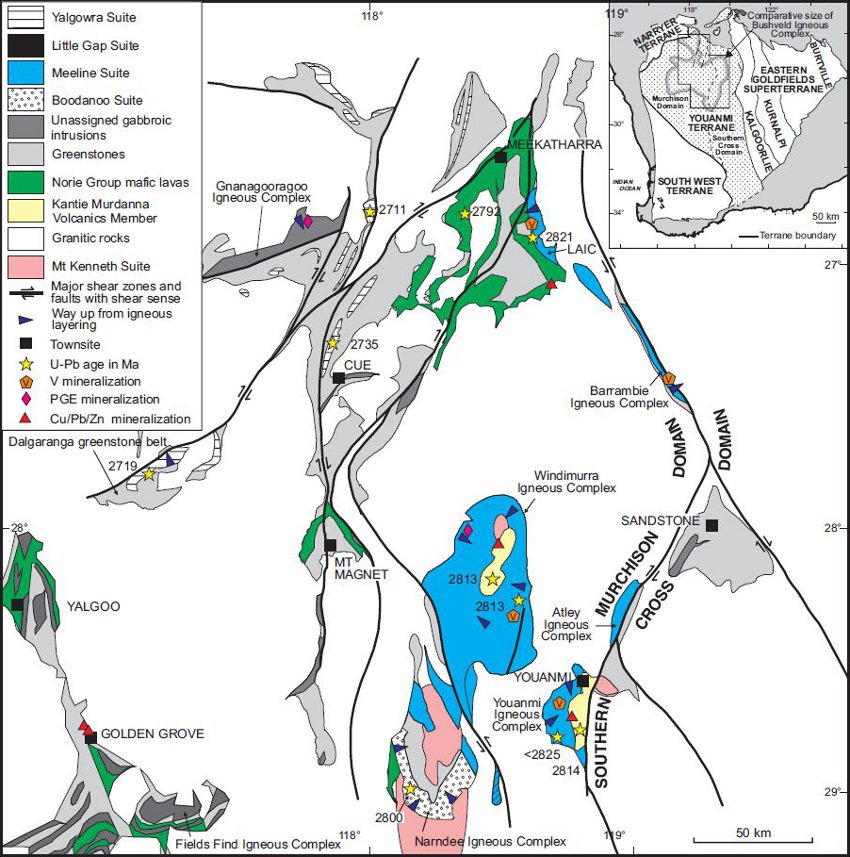
Figure 1 : Simplified geological map of the Murchison Domain, Youanmi Terrane, Yilgarn Craton emphasising the location of c. 2.81 Ga mafic and felsic intrusions, and associated greenstones. LAIC = Lady Alma Igneous Complex. Inset showing area within the Archean Yilgarn Craton.
A large proportion of these lavas and igneous complexes are now steeply dipping and deformed within amphibolite- to greenschist-facies shear zones. However, large remnants of these mafic-ultramafic igneous rocks remain little affected by metamorphism, or by penetrative strain. For example, the Windimurra and Youanmi layered igneous complexes preserve their original conical-inward dipping form and are not significantly tilted. Shallow emplacement depths ~3 km are indicated by contact metamorphosed country rocks (Goscombe pers. comm.)
The igneous complexes are associated with moderate volumes of contemporaneous felsic magmatism (Ivanic et al., 2012). Granitic magmas of the 2815-2800 Ma Mount Kenneth Suite intrude in and around the complexes, and >2 km thick rhyolitic volcanic sequences (e.g. the Kantie Murdanna Volcanics Member) typically directly overly these intrusions (Fig.1). These felsic volcanic rocks have unusual geochemical characteristics of gull-wing shaped REE patterns indicative of derivation from crustal melting. This is interpreted to result from high volumes of magma causing crustal melting.
The combined magmatic products at this time account for >>74,000 km3 (Table 1). As with other Archean terranes, it is difficult to estimate the true volume and must represent vast underestimates because of erosion, tilting, intense deformation and a poorly constrained lateral extent for many of the lavas. The Norie Group mafic-ultramafic lavas have an areal extent of approximately 400 x 350 km (≈ 150,000 km2). If these lavas were on average 3 km thick (general thickness of well preserved greenstone belts) and covered this area entirely, they would constitute ≈ 450,000 km3.
|
|
Approx. volume (km3) |
Associated granitic magmatism (km3) |
Associated rhyolitic volcanism (km3) |
|
Meeline Suite Igneous Complexes |
|
||
|
Windimurra |
>30,000 |
>10 |
>400 |
|
Youanmi |
>4,500 |
>5 |
>300 |
|
Atley |
>1,200 |
Not identified |
Not identified |
|
Lady Alma |
>2,000 |
Not identified |
>50 |
|
Barrambie |
>4,000 |
Not identified |
>50 |
|
Norie Group volcanism |
|
|
|
|
Yalgoo area |
>25,600 |
Not identified |
>5 |
|
Cue area |
>6,000 |
Not identified |
>5 |
|
Total >> 74,125 km3 Including 3 km lava coverage ≈ 495,000 km3
|
|||
Table 1: volume estimates for c. 2.81 Ga magmatism in the Murchison Domain, Youanmi Terrane.
Geochronology
Recent geochronology reveals that this event may extend far to the east of the Murchison Domain, into the Southern Cross Domain and also across into the Eastern Goldfields Superterrane. The event may well have been Yilgarn wide (Fig. 2), therefore the volume estimates (Table 1) potentially represent only a small fraction of the total magmatism in the Yilgarn at this time.
Figure 2 shows that there was a 100 m.y. hiatus in magmatism before the c. 2.81 Ga event from c. 2925-c. 2825 Ma (Van Kranendonk et al., 2012). Norie Group volcanism commenced at c. 2825 Ma. Xenocrystic zircons define maximum ages for several of the Meeline Suite igneous complexes. These xenocrysts are likely derived from the Norie Group host rocks of the Meeline Suite and thereby provide further evidence of widespread magmatism at this time. The Windimurra Igneous Complex has been dated directly at 2813 ± 3 Ma, from a pegmatitic gabbro phase (Wingate et al., 2012a). The Kantie Murdanna Volcanics Member, which immediately overlies the complex, also yields an igneous crystallization age of 2813 ± 3 Ma (Nelson, 2001) from a porphyritic rhyolite flow. Several granites of the Mount Kenneth Suite yield ages between c. 2800 Ma and c. 2815 Ma.
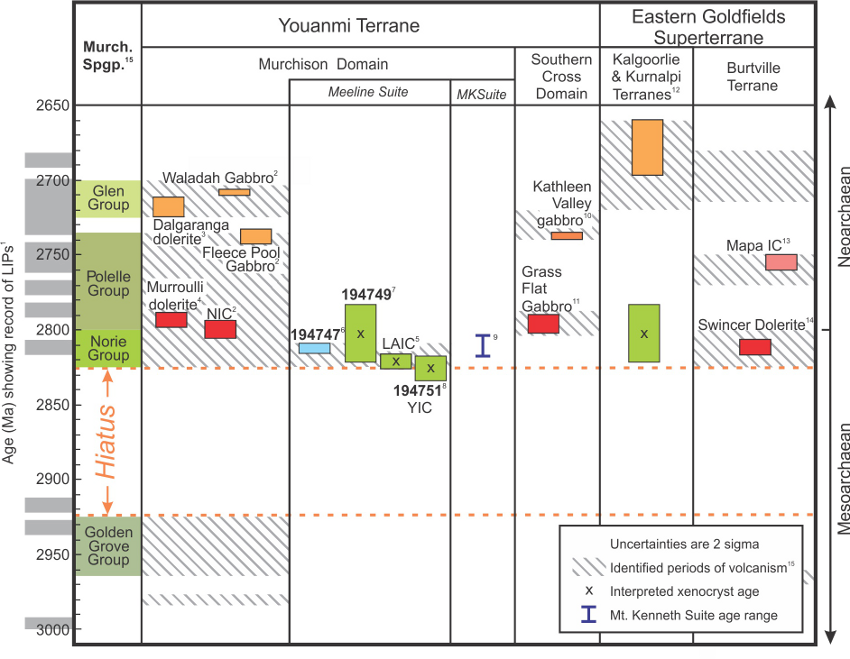
Figure 2 : Summary of geochronology of mafic-ultramafic igneous complexes of the Murchison Domain in relation to the LIP record, known volcanic episodes and in relation to other domains and terranes of the Yilgarn Craton. 1An extract from the global mafic magmatism ‘bar code’ (Ernst et al. 2005) is shown on the left. Ages: 2Ivanic et al. (2010); 3Pidgeon & Hallberg (2000); 4,5Wang (1998); 6,7,8Wingate et al. (2012a,b,c); 9Wingate et al. (in press a,b,c,d); 10Liu et al. (2002); 11Riganti et al. (2010); 12Summarised from: Compston et al. (1986), Woods (1997), Carey (1994) and Kent & McDougall (1995); 13Wingate et al. (2010a); 14Wingate et al. (2010b); 15Summarised from Van Kranendonk et al. (2012).
The first distinctive magma type to postdate the Meeline Suite is that of the 2800 ± 6 Ma hornblende-rich Narndee Igneous Complex (‘NIC’ on Fig. 2). This complex has been dated by baddeleyite and zircon (Ivanic et al., 2010) and the error in these ages do not overlap with those of the Meeline Suite. Therefore this indicates the end of the relatively short-lived 2.81 Ga event and potentially represents a transition or waning phase before the voluminous mafic lavas of the lower Polelle Group (Van Kranendonk and Ivanic, 2009; Van Kranendonk et al., 2012).
Utilising constraints from xenocrystic zircons and the age of the Narndee Igneous Complex, the maximum duration of the 2.81 Ga event is c. 20 m.y. (i.e. c. 2820 – c. 2800 Ma) and the minimum duration is c. 4 m.y. (i.e. c. 2810 – c. 2806 Ma).
Mafic igneous complexes aged c. 2.81 Ga have been dated as far away as the Burtville Terrane, Eastern Goldfields Superterrane (Fig. 2, Wingate et al., 2010b), which lies approximately 500 km to the east of the Windimurra Igneous Complex.
Geochemistry and mineralization
Preliminary results from analyses of REE in samples from the Windimurra Igneous Complex are shown in Figure 3. These yield flat, PM-normalised REE patterns indicating derivation from a large degree partial melting of depleted mantle. Lack of primary hydrous minerals and low LREE, LILE abundances indicate a particularly dry and depleted source. Sm–Nd data indicate that crustal contamination is <2 % in the most contaminated samples and typically << 1% (Ivanic and Nebel, 2012).
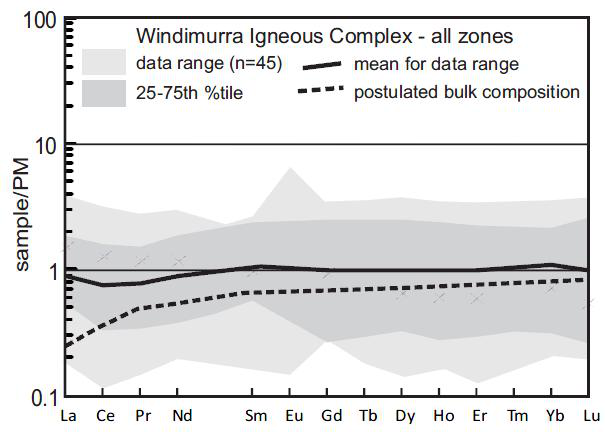
Figure 3 : REE composition of exposed rocks of the Windimurra Igneous Complex. Note: thick dashed line is an estimated bulk composition of the Windimurra Igneous Complex accounting for (i) LREE alteration and (ii) under-representation of ultramafic zone in the dataset, indicating a composition similar to depleted mantle.
The Meeline Suite mafic-ultramafic layered igneous complexes are all associated with significant Fe enrichment in their upper zones, typical of tholeiitic magmas. The upper zones of these are host to significant V–Ti mineralization within magnetitite horizons (Fig. 4). Although the ultramafic bases to these intrusions are rarely exposed, the Windimurra and Youanmi igneous complexes contain some ultramafic rocks, which are host to PGE–Cu–Ni prospects. In addition, there is a peripheral association between these intrusions and overlying, contemporaneous, felsic volcanic hosted Cu–Pb–Zn deposits.
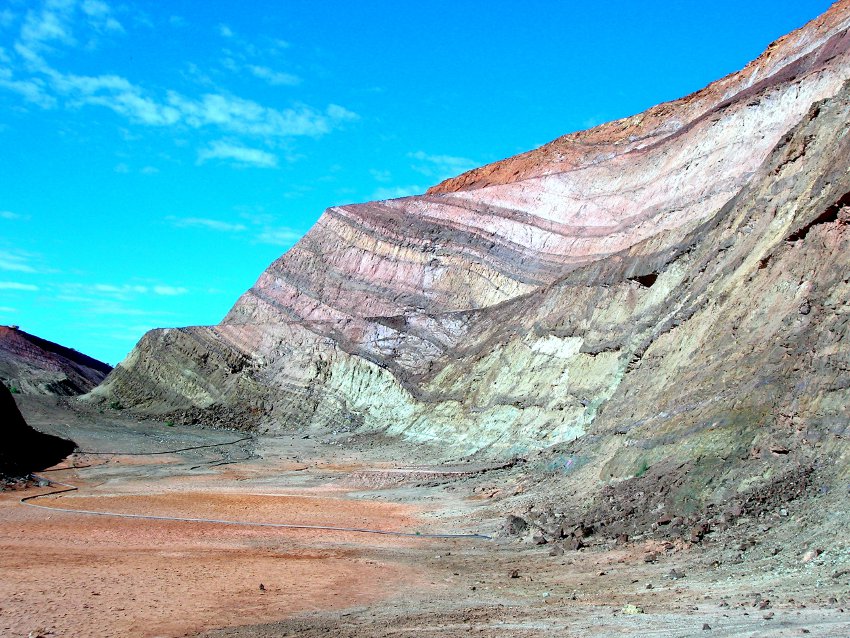
Figure 4 : Photo looking south in the Windimurra vanadium pit with shallowly west-dipping and cyclical magnetitite layers in leucogabbro. Pit wall is ≈40m high.
Lu–Hf data and wider implications
Lu–Hf data from zircons in the Murchison Domain (Fig. 5) indicate the presence of a 3.05 Ga and older basement, which was sampled by subsequent magmatic events. The Meeline Suite (2.81 Ga) and Yalgowra Suite (2.72 Ga) juvenile events (Fig. 5) occur at the same time as significant volumes of felsic magmas which, according to Lu–Hf data, are likely mixtures of juvenile input and various proportions of older basement aged c. 3.05 and c. 3.80 Ga (Ivanic et al., 2012).
Lu–Hf data from the eastern Youanmi Terrane and Eastern Goldfields Superterrane in the eastern Yilgarn Craton indicate five periods crustal growth and recycling – at or before c. 4.2 Ga, at c. 3.5 Ga, at c. 3.1 Ga, at c. 2.8 Ga and at c. 2.7 Ga – with only the later events clearly preserved in the stratigraphic record (Wyche et al., 2012). Hence, material of similar ages to the Meeline Suite in the Murchison Domain (i.e. c. 2.8 Ga vs. c. 2.81 Ga) appears to act as largely unexposed basement, which is subsequently resampled in the Eastern Goldfields Superterrane. These cryptic signatures suggest that the 2.81 Ga mafic events in the Murchison Domain are likely part of a short-lived, Yilgarn-wide thermal event.
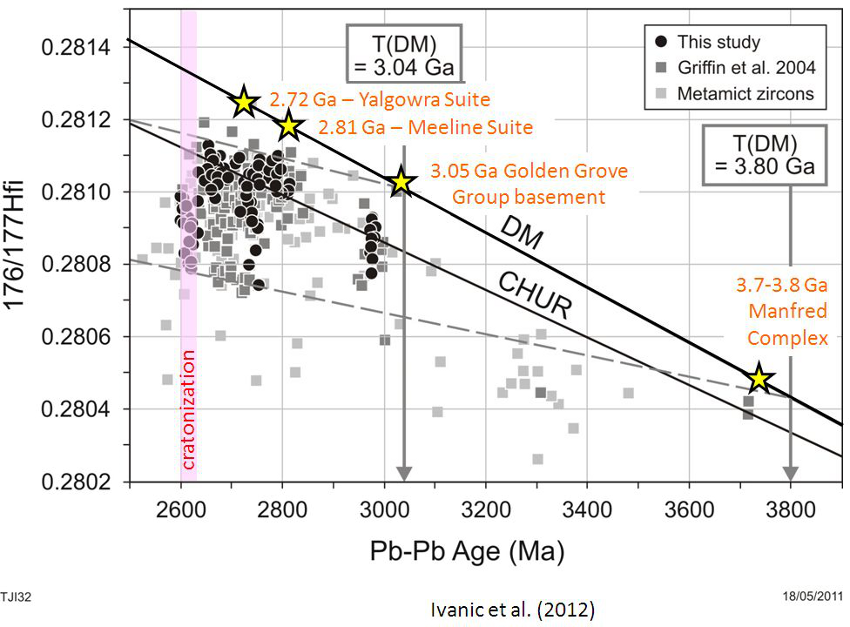
Figure 5 : 176/177Hfi vs. Pb-Pb age (Ma) plot for zircons recovered from GSWA Murchison Domain geochronology samples. Figure adapted from Fig. 7b (Ivanic et al., 2012). Significant crust-forming juvenile events are indicated with yellow stars.
Conclusions
New geochronology has helped to define a large igneous province at 2.81 Ga affecting the Murchison Domain of the Yilgarn Craton. Stratigraphic relations and geochemistry indicate that this voluminous magmatic event was relatively short lived (about 10 m.y.) and responsible for vast layered mafic–ultramafic igneous complexes (Meeline Suite), komatiitic-tholeiitic lavas (Norie Group) and felsic magmas (Mt Kenneth Suite). These magmatic associations fulfil the criteria of a LIP within the Murchison Domain alone. However, several recent studies have shown that 2.81 Ga magmatism is evident over a large part of the 1000 x 1000 km extent of the Yilgarn Craton and is likely to be an extremely voluminous and complex event. A mantle plume is currently the favoured tectonic setting (Ivanic et al., 2010; Ivanic et al., 2012; Van Kranendonk et al., 2012; Wyche et al., 2012).
LIP entries 238 and 262 can be replaced by this newly defined event. In addition, LIP entry 221 can potentially be expanded to encompass 2.72 Ga events in the Murchison Domain.
The Windimurra Igneous Complex preserves geochemical evidence of high-temperature mantle melting of depleted mantle. The Windimurra and other complexes of the Meeline Suite host significant mineral deposits such as magnetitite-hosted V–Ti and ultramafic-hosted PGE–Cu–Ni and they have a possible association with contemporaneous felsic-volcanic hosted Cu–Pb–Zn deposits.
References
Carey, M.L. 1994. Petrography and geochemistry of selected sills from the Kambalda-Kalgoorlie region, WA. B.Sc. (Hons) thesis, Australian National University.
Compston, W., Williams ,I.S., Campbell, I.H., & Gresham, J.J. 1986. Zircon xenocrysts from the Kambalda volcanics: age constraints and direct evidence for older continental crust below the Kambalda Norseman greenstones. Earth and Planetary Science Letters 76, 299-311.
Ernst, R., Buchan, K.L. & Campbell, I.H. 2005. Frontiers in Large Igneous Province research. Lithos 79, 271–297.
Ivanic, T. J., Wingate, M. T. D., Kirkland, C. L., Van Kranendonk, M. J. & Wyche, S. 2010. Age and significance of voluminous mafic–ultramafic magmatic events in the Murchison Domain, Yilgarn Craton. Australian Journal of Earth Sciences 57, 597–614.
Ivanic, T.J., Van Kranendonk, M.J., Kirkland, C.L., Wyche, S., Wingate, M.T.D., & Belousova, E.A. 2012. Zircon Lu–Hf isotopes and granite geochemistry of the Murchison Domain of the Yilgarn Craton: Evidence for reworking of Eoarchean crust during Meso-Neoarchean plume-driven magmatism. Lithos 148. 112–127.
Ivanic, T.J., & Nebel, O. 2012. A dramatic shift from anhydrous to hydrous magmas in the Yilgarn Craton (2810–2800 Ma). 34th International Geological Congress, Brisbane. Abstracts Volume.
Kent, A.J.R, & MacDougall, I. 1995. 40Ar-39Ar and U-Pb age constraints on the timing of gold mineralization in the Kalgoorlie goldfields, Western Australia. Economic Geology 90, 845-859.
Liu, S. F., Champion, D. C. & Cassidy, K. F. 2002. Geology of the Sir Samuel 1:250 000 sheet area, Western Australia: Geoscience Australia, Record 2002/14, 57 p.
Nelson, D. R. 2001a. 169003: vesicular rhyolite, Carron Hill. Geochronology Record 170, Geological Survey of Western Australia, 4p.
Pigeon, R. T., & Hallberg, J. A. 2000. Age relationships in supracrustal sequences of the northern part of the Murchison Terrane, Archaean Yilgarn Craton, Western Australia: a combined field and zircon U-Pb study: Australian Journal of Earth Sciences 47, 153-165.
Riganti A., Wyche, S., Wingate, M. T. D., Kirkland, C. L., & Chen, S. F. 2010. Constraints on ages of greenstone magmatism in the northern part of the Southern Cross Domain, Yilgarn Craton. In: Tyler I. M. & Knox-Robinson C. M. eds. Fifth International Archean Symposium abstracts, pp. 119–122. Geological Survey of Western Australia Record 2010/18.
Van Kranendonk, M.J. 2008. New evidence on the evolution of the Cue–Meekatharra area of the Murchison domain, Yilgarn Craton. Geological Survey of Western Australia, Annual Review 2006-07, 39-49.
Van Kranendonk, M. J., & Ivanic, T. J. 2009. A new lithostratigraphic scheme for the northeastern Murchison Domain, Yilgarn Craton: Geological Survey of Western Australia, Annual Review 2007–08, 34–53.
Van Kranendonk, M.J., Ivanic, T.J., Wingate, M.T.D., Kirkland, C.L., & Wyche, S. 2012: Long-lived, autochthonous development of the Archean Murchison Domain, Yilgarn Craton. Precambrian Research, in press.
Wang, Q. 1998. Geochronology of the granite-greenstone terranes in the Murchison and Southern Cross Provinces of the Yilgarn Craton, Western Australia. Unpublished Ph.D. thesis. Australian National University, Canberra, 186p.
Watkins, K. & Hickman, A. 1990. Geological evolution and mineralization of the Murchison province: Geological Survey of Western Australia Bulletin 137.
Wingate, M. T. D., Kirkland, C. L., & Pawley, M. J. 2010a, 185976: leucogabbro, Mount Warren. Geochronology Record 870, Geological Survey of Western Australia.
Wingate, M. T. D., Kirkland, C. L., & Pawley, M. J. 2010b. 185968: leucogabbro, Mount Sefton. Geochronology Record 869, Geological Survey of Western Australia.
Wingate, M.T.D., Kirkland, C.L., & Ivanic, T.J. 2012a. 194747: metagabbro, Malamiter Well. Geochronology Record 1013. Geological Survey of Western Australia.
Wingate, M.T.D., Kirkland, C.L., & Ivanic, T.J. 2012b. 194749: metagabbronorite, Top Bundlejenny Well. Geochronology Record 1014. Geological Survey of Western Australia.
Wingate, M.T.D., Kirkland, C.L., & Ivanic, T.J. 2012c. 194751: metadolerite, Freddie Well. Geochronology Record 1015. Geological Survey of Western Australia.
Wingate, M.T.D., Kirkland, C.L., & Ivanic, T.J. 2012d. 193967: hornblende–biotite granodiorite, Mount Kenneth Bore. Geochronology Record 1010. Geological Survey of Western Australia.
Wingate, M.T.D., Kirkland, C.L., & Ivanic, T.J. in press a. 185995: foliated granite. Geochronology Record. Geological Survey of Western Australia.
Wingate, M.T.D., Kirkland, C.L., & Ivanic, T.J. in press b. 185996: foliated granite. Geochronology Record. Geological Survey of Western Australia.
Wingate, M.T.D., Kirkland, C.L., & Ivanic, T.J. in press c. 198209: felsic gneiss. Geochronology Record. Geological Survey of Western Australia.
Wingate, M.T.D., Kirkland, C.L., & Ivanic, T.J. in press d. 198210: foliated metagranite. Geochronology Record. Geological Survey of Western Australia.
Woods, B.K. 1997. Petrogenesis and geochronology of felsic dykes in the Kalgoorlie Terrane, Kalgoorlie, Western Australia. B.Sc. (Hons) thesis, Curtin Univeristy of Technology.
Wyche, S., Kirkland, C. L., Riganti, A., Pawley, M. J., Belousova, E., & Wingate, M. T. D. 2012. Isotopic constraints on stratigraphy in the central and eastern Yilgarn Craton, Western Australia, Australian Journal of Earth Sciences 59. 657-670.
